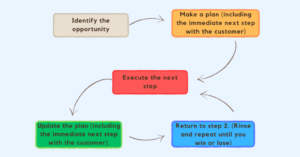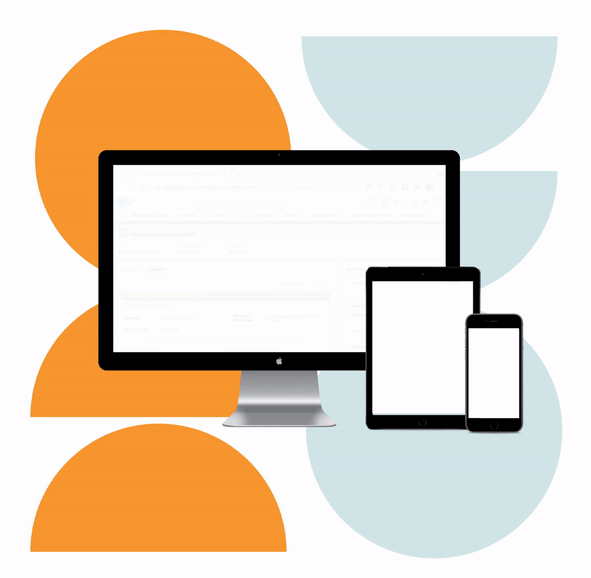Common Pitfalls in Implementing the Miller Heiman Blue Sheet
Avoiding Sales Process Blind Spots
The “Blue Sheet”, launched by Miller Heiman in 1978 as a strategic selling tool for complex sales, has become a safe choice for sales leaders looking to plan their account management approach for opportunities within their larger, more complex accounts.
It’s a worthwhile and commonly used tool, allowing salespeople to develop a better understanding of the key decision makers, economic buyers, technical buyers other stakeholders, red flags and risks as they navigate the complex sale.
But having advised hundreds of enterprise sales leaders over the last twenty years, we’ve seen a large proportion of them implement Miller Heiman Blue Sheet, but leave a gaping hole in their overall sales process and methodology.

Strategic Selling – The Missing “Third Leg” of the Stool
In complex sales, the sales methodology itself should not be complex. One of the most important attributes of high performing sales teams is the ability to distill – they can make their sales process simple; not only for themselves, but for their customers.
In designing an effective sales process, most sales leaders and sales operations teams focus on two main areas:
- Pipeline analytics, and
- Account management and planning
Lets discuss these two, then take a look at what’s missing.
Pipeline analytics
With the evolution of CRM software as a platform that can run OEM and third party “apps”, pipeline analytics has become flavor of the month. Salesforce and Microsoft Dynamics have the largest CRM market share for enterprise sales teams, with their own pipeline analytics tools (Tableau and Power BI respectively) leading the charge.
Most large sales teams have multiple customized dashboards for leadership showing pipeline velocity, stalled deals, average contract value and a variety of other KPIs on a per-rep, per-territory basis.
These pipeline analytics dashboards have become the primary means of forecasting and performance management for sales leaders.
For shorter sales cycles (weeks to a few months), pipeline velocity and analytics is a great tool to assess sales capabilities and forecast. But as sales cycles get longer with more complex sales motions, pipeline increasingly becomes a backward-looking tool.
In the most complex sales, such as healthcare solutions involving expensive capital, or enterprise software that requires organizational “workflow” change for their customers, sales cycles can run for 6, 12, 18 months or even more. Pipeline velocity is effectively meaningless for this cycle. There is nothing so disappointing or expensive as coming in second on an 18 month sales opportunity, and only realizing afterwards that the AE running the deal lacked the competencies needed to deliver a win.
Account Management
This is where good account planning becomes really important. Understanding the coverage you have on an account and potential gaps (red flags) can surface problems early.
The Blue Sheet (developed by the Miller Heiman Group, which is now owned by Korn Ferry) does a decent job at this, providing a “strategic selling” template with buying influences, green and red flags and potential next steps in the sale.
If you’re wanting to run account planning as software on your CRM, it’s available as an app, and there are also lots of other good quality account planning CRM software tools including Upland Altify with its visually interesting “relationship map”, and the SWIFT productivity app from Swagger Sales.
What’s missing?
On its own, account planning software helps front-line managers coach deals. But it does almost nothing to help coach people – their behaviors, competencies and skills. And if your salespeople aren’t equipped with the skills to execute their key customer-facing meetings really well, including the ability to really uncover and influence stakeholder priorities, motivators and positions, you end up with a bunch of beautifully formed strategic selling blue sheets, but populated with low quality data.
If you’ve ever been surprised by losing a big deal after your sales rep running it assured you that you were well positioned, you’ll appreciate this problem.
Garbage in, garbage out.

Because, at its most basic level, the execution of every B2B sales process, every opportunity and every sales methodology can be boiled down to something really simple:
- Identify the opportunity. Make a plan (including the immediate next step with the customer),
- Execute the next step,
- Update the plan (including the immediate next step with the customer).
- Return to step 2. (Rinse and repeat until you win or lose)

Selling skills
The proliferation of sophisticated pipeline analytics and account planning software tools has blinded many sales leaders to the need to build a sales team that really knows how to sell. We don’t mean your team’s ability to plan strategy – we mean the customer-facing skills that allow them to advance the ball on critical meetings.
Focus a little less on strategy, and a little more on tactics and skills. Old-school skills like gaining credibility early, questioning and prioritization skills, listening skills, the ability to monetize customer value to avoid commoditization, the confidence to make earlier credible proposals, and the ability to “close for an advance” with a firm, energetic agreement of next steps.
Many sales organizations throw sales training at new hires, but assume that their tenured salespeople know how to sell. But when we run advanced enterprise sales training and video-tape realistic meeting simulations or rehearse critical meetings for our clients, we find competency gaps in even the highest-performing salespeople.
Without these skills, you’re executing a thorough account plan poorly. And surfacing and fixing skills gaps is critical to driving sales productivity.
The Sales Management gap
Your front line sales managers are usually the most important and leveraged role in your sales organization. With 6-10 direct reports, they typically manage a payroll of one to three million dollars. And for B2B enterprise solutions, the sales team’s quota can be tens of millions of dollars.
Yet if you ask most VP Sales or Chief Revenue Officers which of their front-line managers really know how to coach, they’ll struggle. And if you ask a front-line manager to explain which specific skills gaps exist in each person on her team and which behaviors and skills they’re coaching for each person, you’ll often get “crickets”.
You’ll find nothing in most account planning tools (including the Miller Heiman Blue Sheet) that help managers coach people. The focus is almost exclusively coaching the deal, the red flags and gaps.
If you look at the bottom right corner of a Blue Sheet, you’ll find a section covering “What information do we need, what actions need to be taken, who will take them”.
But there is no “HOW” will we do it, or “HOW WELL” are we doing it.
And if your team isn’t equipped to execute the big meetings that really move the needle on complex sales, Miller Heiman Sales Methodology won’t save you. No account planning tools on earth will save you.
How to plug the gap
Don’t forget the third leg of the stool.
Remember that salespeople need to know how to sell, and managers need to be able to coach.
By selling, we don’t mean just updating an account plan and submitting a regular forecast. We mean executing the key customer-facing meetings that ultimately drive every large opportunity.
Choose a good account planning tool, but don’t overthink it. (Miller Heiman Blue Sheet, Upland Altify, Swagger Sales’ SWIFT or one of the many other good ones on the market all work well). Your account planning tools ultimately matter less than you think – they are, after all, a template. Many surprisingly large and successful sales teams work with little more than a well-designed excel spreadsheet as an account planning tool.
In most cases, a decent plan executed well beats a perfect plan executed poorly.
Invest more of your time (and sales process budget) evaluating sales training, tools and processes that support the coaching skills of your front-line managers so they can build sustainable sales “muscle” in their salespeople.
Building Sales “Muscle”
Consider these steps:
- Develop a simple, product-agnostic competency framework for reps. It continues to amaze me how many sales organizations don’t define the characteristics of great sales professionals, including (of course) customer-facing selling skills.
- Implement a simple, robust pre-call planning process, and train your team on planning for the biggest, most important meetings. Complex sales are not linear – a small number of critical meetings tend to define your win rates – a big meeting can move the needle forward a long way, or stop a deal dead in its tracks. Call planning is one of the biggest overlooked areas we see in enterprise sales teams and the selling process.
- Train your front-line managers in observational skills, competency assessment and coaching, and make this part of their performance metrics/KPIs. Have them focus field travel time not on helping deals, but on assessing competencies and gaps of their reps. Pre-Call Plans for field travel are an essential tool to support this. Most managers are “promoted super-reps” – they have no trouble coaching deals because they were usually really good salespeople. But coaching other people to sell is a very different skill to selling as an individual contributor. Simple, robust call plans are an invaluable tool for managers to properly debrief meetings that went well, and those that did not.
- Invest in the software tools that help them focus on coaching people, not just deals. The SWIFT app (currently available on Salesforce CRM only) provides a turn-key solution for call planning, coaching, competency assessment. It has the additional significant benefit of providing drill-down competency dashboards for sales leaders, driving a level of coaching accountability for large sales teams that drives ongoing performance improvement.
If you are interested in transforming your CRM into a coaching engine to drive productivity, check out our SwaggerSWIFT product. If you would like us to show you how it works, please schedule a demo at a time that is convenient for you. Feel free to contact us with any questions you may have.
25 Minutes Can Transform Your Business
SWIFT™ turns your CRM from a database into a high performance sales engine with integrated call planning, coaching and competency assessment.
We’ll demonstrate how this Salesforce plug-in can drive discipline, accountability and performance across your sales team.

